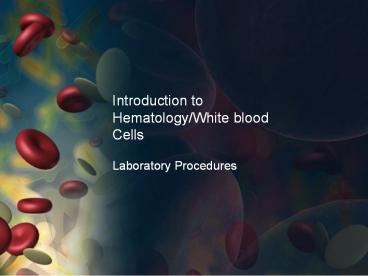Introduction to Hematology/White blood Cells - PowerPoint PPT Presentation
Title: Introduction to Hematology/White blood Cells
1
Introduction to Hematology/White blood Cells
- Laboratory Procedures
2
Blood components
- All blood cells arise from the same stem cell.
In response to various chemical messengers,
called cytokines, the stem cells begin to
differentiate into one of two types, myeloid or
lymphoid. - Further differentiation in response to additional
cytokines results in forming cell types. The
primary cytokine responsible for erythrocyte
production is erythropoietin (EPO) - The myeloid line differentiates into
erythroblasts which become erythrocytes,
megakaryoblasts, which become platelets, and the
myeloblast, which become granulocytes and
monocytes. - The lymphoid line differentiates into
lymphoblasts which become lymphocytes.
3
(No Transcript)
4
Terminology
- Erythrocyte Red Blood Cell (RBC)
- LeukocyteWhite Blood Cell (WBC)
- 5 main types of white blood cells which include
three granulocytes.
5
Functions of Leukocytes
- Granulocytes
- Characterized by the presence of cytoplasmic
granules - Function of these cells occurs in the tissues,
not in the bloodstream. - These cells do not recirculate
6
Granulocytes
- Neutrophils
- Basophils
- Eosinophils
- Produced predominately in the bone marrow.
- Capable of mitotic division up to the myelocyte
stage. - Responds to an increased demand
- infection
- Takes 3-5 days to influence peripheral numbers.
7
Neutrophil front line in battle
- These are usually the most numerous leukocytes in
the blood and are primarily responsible for
fighting infections
8
Granulocytes Neutrophils
9
Segmented neutrophil Mature cells that have a
segmented, irregular shaped nucleus.
10
lymphocyte
eosinophil
Segmented neutrophil
11
Band Neutrophil An immature cell characterized
by a horseshoe shaped nucleus
12
Neutrophil Hypersegmentation
- Neutrophils with five or more nuclear lobes.
- Normal aging change of neutrophils which normally
occurs in the tissues, not bloodstream. - May occur with excessive levels of
corticosteroids from administration or
hyperadrenocorticism. - Chronic inflammation.
- Artifactual change in the blood that sits for a
period of time.
13
Hyper-segmented neutrophil A senior cell that
is characterized by having 5 or more lobes in
the nucleus.
14
(No Transcript)
15
Eosinophils
- Inhibit chemical mediators such as histamine and
serotonin which are released during allergic
(hypersensitivity reactions). - Have phagocytic and bacteriocidal properties
similar to neutrophils but not as effective. - Have parasiticidal properties.
- Animals with heartworms may have high numbers of
eosinophils.
16
Eosinophil the allergy slayerEosinophil red
granules compare the color to the erythrocytes
17
- Under normal conditions, they do not return to
circulation after reaching the tissue. There are
300 400 eosinophils in the bone marrow for
every one circulating in the blood.
18
Basophils
- Secrete mediators of inflammation (histamine)
associated with hypersensitivity reactions. - This release occurs when antigens complex with
IgE is located on the cellular surface.
19
Basophils the unknown stranger
- Basophils have a poorly defined function and are
relatively rare in canine and feline blood,
however they are thought to have some function in
inflammatory response
20
Normal morphology of Granulocytes
- Neutrophils multiple nuclear lobules separated
by constrictions. - Band granulocytes band (horseshoe) shaped
nuclei. - Eosinophil Lobulated nucleus and cytoplasm
containing reddish pink granules. - Basophil Lobulated nucleus and purple-blue
(Basophilic) granules.
21
Lymphocytes
- Distributed in lymphoid tissue to include lymph
nodes, spleen, thymus, tonsils, bone marrow, and
blood. - Capable of division.
- Recirculate in the blood.
- Functions
- B cells turn into plasma cells which secrete
immunoglobulins. Usually stayin the lymphoid
tissue. - T cells transform into effector cells that
produce lymphokines which function in mediation
of cellular immunity.
22
- Lymphocyte guard dog of the bodyThese are the
second most common leukocyte in the blood and
their primary function is immune regulation.
23
- In the mature cell, the nucleus is round and
occupies most of the cell. These cells will be
slightly smaller than neutrophils
24
B cell
25
T cell
26
Monocytes
- Differentiate into the cells of the
mononuclear/phagocyte system present in most
tissues. - Become macrophages once they migrate into the
tissues. - Capable of multiplying within the tissues.
- Can survive for long periods of time
27
Monocyte Functions
- Phagocytosis and digestion of particulate
material, bacteria, and dead cells. - Macrophages are less responsive to bacterial
infections than neutrophils but are more
effective against fungal infections. - Synthesis and release of substances involved in
inflammation and immune response. - Expressions of immune response by presenting
antigens to T-lymphocytes. - Serve as a major source of colony stimulating
factors and cytokines involved in hematopoiesis. - Cause bone marrow to produce more granulocytes.
28
Monocyte buzzard in the blood
- These are the third most common cell seen in the
blood and they have diverse functions. The
primary function is to seek out invaders and eat
them.
29
- Once they have been called to help fight an
infection, the monocyte will move into the tissue
and transform into a macrophage (big eater).
They can complete this transformation in about 24
hours
30
(No Transcript)































